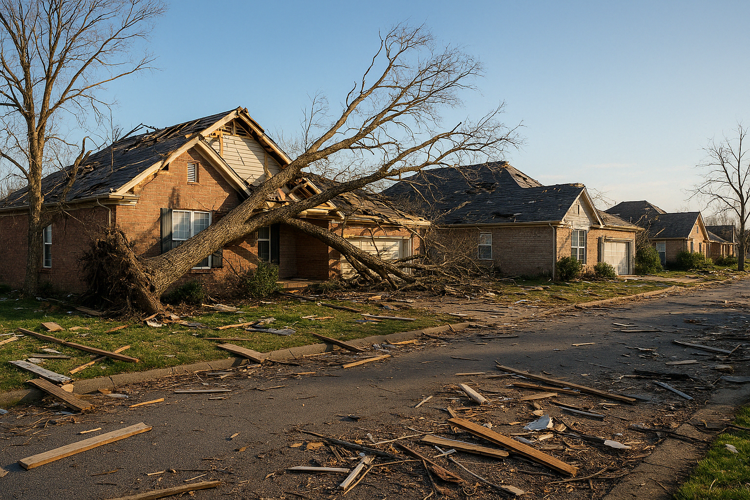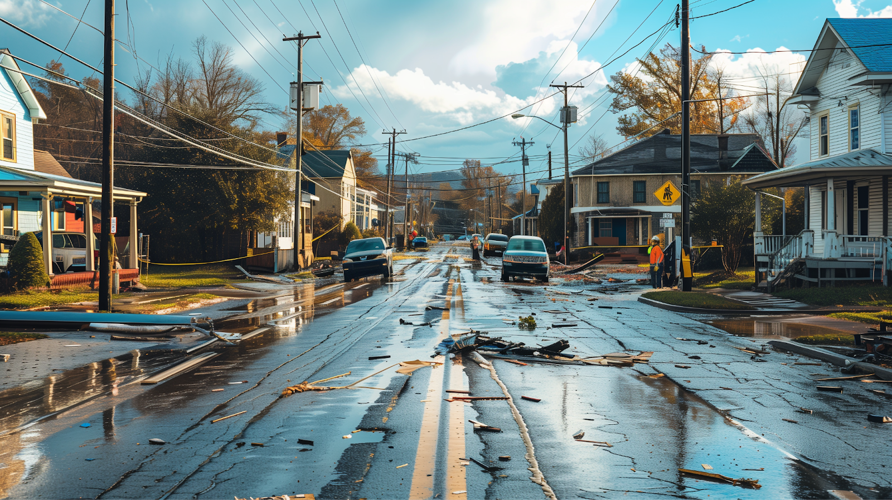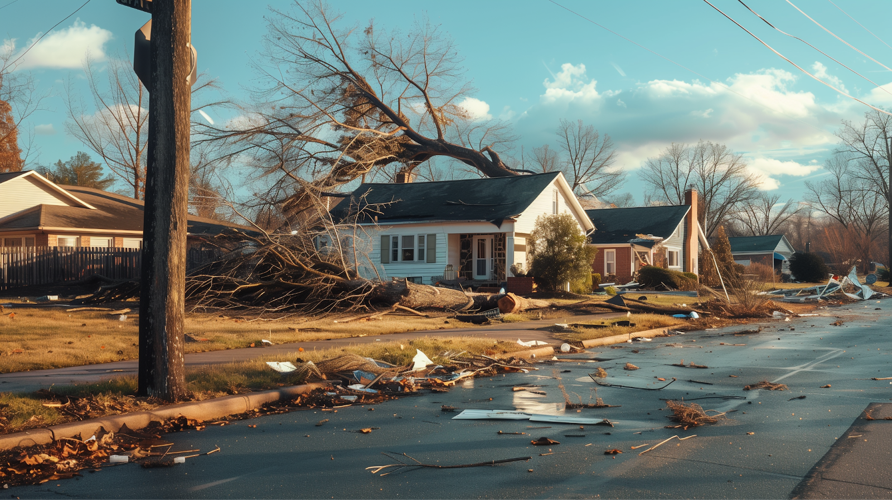
A powerful storm in Clarksville TN recently struck, causing significant damage and power outages. This guide provides essential safety tips, steps to assess damage, and advice on dealing with repairs and insurance.
Key Takeaways
Safety first after a storm: Stay away from downed power lines and assess any visible roof damage from the ground before seeking professional help.
File insurance claims quickly and keep thorough documentation of damage, expenses, and communications to speed up the reimbursement process.
Invest in preventive measures for future storms, such as gutter maintenance and storm shutters, to protect your home and avoid costly repairs down the line.
Immediate Steps After a Storm
The first priority after a storm is safety. Steer clear of downed power lines and floodwaters, which pose serious risks of electrocution or drowning. Treat intersections without power as four-way stops to avoid accidents.
Operate generators outdoors to avoid carbon monoxide poisoning while you wait for power to be restored and to ensure you have a place to rest. These actions help prevent further harm and prepare for recovery, especially in case of a fire.

Assessing Roof Damage
After ensuring safety, assess your roof’s condition. Use binoculars from the ground to spot visible damage, avoiding the hazards of climbing. Look for missing, broken, or curled shingles, and any sagging areas that suggest structural issues.
Water leaks during rain indicate holes or cracks needing urgent repair. Light entering from the roof also signals potential damage. Contact a professional roofing contractor if you suspect significant issues to prevent further risks.
Mold or moss on the roof can deteriorate materials, requiring timely intervention. A professional roof inspection is vital to fully assess and determine necessary repairs or replacement.
Contacting Your Insurance Adjuster
File your insurance claim promptly after assessing the damage to expedite the process immediately. Maintain effective communication with your insurance adjuster, and thoroughly document the damage with photos and an inventory to assist in claim assessment.
Maintain a detailed log of all communications about storm damage for your insurance claims. Document repair expenses with receipts for reimbursement processes, and take photos of the damage before repairs to support your claims with visual evidence.
Choosing a Reputable Roofing Contractor
Choosing the right roofing contractor is key to successful repairs or replacement. Request a comprehensive written estimate from multiple contractors to ensure fair pricing and understand the scope of work. A reputable contractor will thoroughly inspect the roof to determine necessary repairs or replacement.
Check references from previous customers to gauge the contractor’s service level and customer satisfaction. Effective communication and responsiveness during initial interactions indicate how well the contractor will handle the project.
Choosing the best choice contractor isn’t just about the lowest price; it’s about finding a reputable company professional who provides quality workmanship and professionalism and stands by their team with integrity, dedication, job, and pride.
Temporary Repairs to Prevent Further Damage
While awaiting professional repairs, temporary fixes can prevent further damage. Simple actions like pounding spikes back into loose gutters and replacing popped nails on your deck with deck screws can be effective.
Cover damaged windows with plywood or durable plastic to keep out rain and pests. Relocate furniture and valuables to higher ground to reduce the risk of further damage during flooding.
Clear clogs in downspouts using a garden hose with a pressure nozzle to improve drainage. Keep receipts for temporary repairs, as they may be necessary for full insurance coverage.
Scheduling Professional Roof Inspections
A professional roof inspection detects damage that could lead to moisture problems and health issues from mold and mildew. Regular inspections extend your roof’s lifespan and help avoid costly secondary damage.
Professional assessments provide peace of mind about your roof’s condition. Increased energy bills may indicate a damaged roof, as it lets air escape, forcing HVAC systems to work harder. Roofs, especially asphalt shingles, typically require replacement after 15-20 years.
Understanding Repair vs. Replacement
Choosing between roof repairs and a full roof repair or a full replacement depends on the damage extent and overall condition. Frequent repairs suggest unreliability, and regular leaks may warrant a full replace. Minor repairs can suffice for small damages, but major structural issues usually require complete replacement.
Repeated repair costs add up, making a new roof more economical long-term. Consult a professional roofing contractor to assess the roof and determine if repair or replacement is needed. Many roofing warranties require annual inspections to remain valid.
Gutter and Downspout Maintenance
Maintaining gutters and downspouts prevents water damage to your roof and home. Blocked gutters cause water overflow and roof damage, making regular maintenance essential. Routine inspections reveal drainage issues from clogs, preventing leaks and deterioration.
Regular maintenance checks identify vulnerabilities in your home’s structure before storms. Well-maintained gutters and downspouts ensure effective drainage during heavy rain, reducing water damage risk.

Protecting Your Home from Future Storms
Protecting your home from future storms requires proactive measures. Install storm shutters to reduce wind and debris damage. Reinforce garage doors with additional bracing to withstand storm impacts. Use impact-resistant windows for better protection.
Secure outdoor furniture and decor regularly to prevent them from becoming projectiles in strong winds. Gutter guards reduce maintenance by keeping debris out, and downspout extensions direct water away from the foundation to prevent pooling.
New roofing materials offer better energy efficiency, leading to lower energy bills and justifying the replacement investment. These efficient measures protect your property, family, and business from future storms while ensuring durability and improvement.
Cost Considerations and Financing Options
Storm damage repairs can be costly, with expenses for materials, labor, and possible permit charges. Financing options include personal loans, home equity lines of credit, and insurance claims. Government assistance programs may help cover repair costs after significant storm damage.
Avoid paying for roofing work in advance; most roofing companies expect payment upon completion for their projects. Here are some tips for contractors offering financing options that may have stable money business models, as lenders often vet them before providing financial services.
Loss of use coverage can assist with living expenses if your house becomes uninhabitable due to damage in your life.
The Role of Community Support
Community support is vital for helping homeowners recover from storm effects, fostering unity and resilience. Local organizations provide resources like shelters, food supplies, and financial assistance. Communities sharing knowledge and skills contribute to faster, comprehensive recovery.
Homeowners should use social media platforms and local community boards to share information about available resources and recovery efforts. Creating neighborhood groups facilitates communication and support among residents during recovery.
Maintaining Documentation
Maintain documentation of repairs, expenses, and communications to have records for insurance claims and personal reference. A well-kept homeowner’s journal is helpful for future repairs and insurance interactions.
Store documents in a waterproof container to protect essential papers from storm damage, ensuring they are covered from potential harm.
Summarize the key points covered in the article, emphasizing the importance of safety, proper damage assessment, and proactive measures to protect your home. Highlight the role of community support in recovery efforts and the importance of maintaining documentation for insurance claims and future reference.
End with an inspiring note on the resilience of homeowners and communities, encouraging readers to take the necessary steps to protect their homes and foster a strong, supportive community spirit.
Frequently Asked Questions
What should I do immediately after a storm?
Right after a storm, your top priority should be safety—stay away from downed power lines and floodwaters, treat intersections like four-way stops, and keep generators outside to prevent carbon monoxide buildup. Stay safe out there!
How can I assess roof damage safely?
You can safely assess roof damage by using binoculars from the ground to check for issues, and if you see anything concerning, it's best to call in a pro to take a closer look.
How do I file an insurance claim for storm damage?
To file an insurance claim for storm damage, act quickly and document everything with photos while keeping track of all communications and repair costs. This will help you streamline the process and get your claim approved faster.
What temporary repairs can I make to prevent further damage?
To prevent further damage, secure those loose gutters, cover up any damaged windows, and move your valuables to higher ground. Don't forget to clear the downspouts with a garden hose!
How can I protect my home from future storms?
To really safeguard your home from future storms, consider installing storm shutters and impact-resistant windows, reinforcing garage doors, securing outdoor furniture, and adding gutter guards. These steps can make a big difference!




(0) comments
We welcome your comments
Log In
Post a comment as Guest
Keep it Clean. Please avoid obscene, vulgar, lewd, racist or sexually-oriented language.
PLEASE TURN OFF YOUR CAPS LOCK.
Don't Threaten. Threats of harming another person will not be tolerated.
Be Truthful. Don't knowingly lie about anyone or anything.
Be Nice. No racism, sexism or any sort of -ism that is degrading to another person.
Be Proactive. Use the 'Report' link on each comment to let us know of abusive posts.
Share with Us. We'd love to hear eyewitness accounts, the history behind an article.